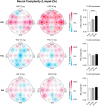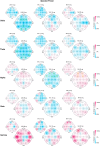Neural complexity is increased after low doses of LSD, but not moderate to high doses of oral THC or methamphetamine
- PMID: 38287172
- PMCID: PMC11109226
- DOI: 10.1038/s41386-024-01809-2
Neural complexity is increased after low doses of LSD, but not moderate to high doses of oral THC or methamphetamine
Abstract
Neural complexity correlates with one's level of consciousness. During coma, anesthesia, and sleep, complexity is reduced. During altered states, including after lysergic acid diethylamide (LSD), complexity is increased. In the present analysis, we examined whether low doses of LSD (13 and 26 µg) were sufficient to increase neural complexity in the absence of altered states of consciousness. In addition, neural complexity was assessed after doses of two other drugs that significantly altered consciousness and mood: delta-9-tetrahydrocannabinol (THC; 7.5 and 15 mg) and methamphetamine (MA; 10 and 20 mg). In three separate studies (N = 73; 21, LSD; 23, THC; 29, MA), healthy volunteers received placebo or drug in a within-subjects design over three laboratory visits. During anticipated peak drug effects, resting state electroencephalography (EEG) recorded Limpel-Ziv complexity and spectral power. LSD, but not THC or MA, dose-dependently increased neural complexity. LSD also reduced delta and theta power. THC reduced, and MA increased, alpha power, primarily in frontal regions. Neural complexity was not associated with any subjective drug effect; however, LSD-induced reductions in delta and theta were associated with elation, and THC-induced reductions in alpha were associated with altered states. These data inform relationships between neural complexity, spectral power, and subjective states, demonstrating that increased neural complexity is not necessary or sufficient for altered states of consciousness. Future studies should address whether greater complexity after low doses of LSD is related to cognitive, behavioral, or therapeutic outcomes, and further examine the role of alpha desynchronization in mediating altered states of consciousness.
© 2024. The Author(s), under exclusive licence to American College of Neuropsychopharmacology.
Conflict of interest statement
The authors declare no competing interests.
Figures




Similar articles
-
Low doses of LSD reduce broadband oscillatory power and modulate event-related potentials in healthy adults.Psychopharmacology (Berl). 2022 Jun;239(6):1735-1747. doi: 10.1007/s00213-021-05991-9. Epub 2021 Oct 6. Psychopharmacology (Berl). 2022. PMID: 34613430 Free PMC article. Clinical Trial.
-
Lack of behavioral sensitization after repeated exposure to THC in mice and comparison to methamphetamine.Psychopharmacology (Berl). 2007 Sep;193(4):511-9. doi: 10.1007/s00213-007-0811-2. Epub 2007 May 12. Psychopharmacology (Berl). 2007. PMID: 17497137 Free PMC article.
-
Inter-individual variability in neural response to low doses of LSD.Transl Psychiatry. 2024 Jul 15;14(1):288. doi: 10.1038/s41398-024-03013-8. Transl Psychiatry. 2024. PMID: 39009578 Free PMC article. Clinical Trial.
-
Microdosing Psychedelics: Current Evidence From Controlled Studies.Biol Psychiatry Cogn Neurosci Neuroimaging. 2024 May;9(5):500-511. doi: 10.1016/j.bpsc.2024.01.002. Epub 2024 Jan 26. Biol Psychiatry Cogn Neurosci Neuroimaging. 2024. PMID: 38280630 Review.
-
Dose-response relationships of LSD-induced subjective experiences in humans.Neuropsychopharmacology. 2023 Oct;48(11):1602-1611. doi: 10.1038/s41386-023-01588-2. Epub 2023 May 9. Neuropsychopharmacology. 2023. PMID: 37161078 Free PMC article.
Cited by
-
Intoxication due to Δ9-tetrahydrocannabinol is characterized by disrupted prefrontal cortex activity.Neuropsychopharmacology. 2024 Aug;49(9):1481-1490. doi: 10.1038/s41386-024-01876-5. Epub 2024 May 7. Neuropsychopharmacology. 2024. PMID: 38714786 Free PMC article. Clinical Trial.
-
Addressing blinding in classic psychedelic studies with innovative active placebos.Int J Neuropsychopharmacol. 2025 Apr 11;28(4):pyaf023. doi: 10.1093/ijnp/pyaf023. Int J Neuropsychopharmacol. 2025. PMID: 40183712 Free PMC article. Review.
-
Psilocybin-assisted neurofeedback for the improvement of executive functions: a randomized semi-naturalistic-lab feasibility study.Philos Trans R Soc Lond B Biol Sci. 2024 Dec 2;379(1915):20230095. doi: 10.1098/rstb.2023.0095. Epub 2024 Oct 21. Philos Trans R Soc Lond B Biol Sci. 2024. PMID: 39428872 Clinical Trial.
-
An investigation of acute physiological and psychological moderators of psychedelic-induced personality change among healthy volunteers.Neurosci Appl. 2024 Dec 2;4:104092. doi: 10.1016/j.nsa.2024.104092. eCollection 2025. Neurosci Appl. 2024. PMID: 40654586 Free PMC article.
-
LSD flattens the hierarchy of directed information flow in fast whole-brain dynamics.Imaging Neurosci (Camb). 2025 Jan 3;3:imag_a_00420. doi: 10.1162/imag_a_00420. eCollection 2025. Imaging Neurosci (Camb). 2025. PMID: 40800760 Free PMC article.
References
-
- Fadiman J. The Psychedelic Explorer’s Guide: Safe, Therapeutic, and Sacred Journeys. Inner Traditions/Bear; 2011.
Publication types
MeSH terms
Grants and funding
LinkOut - more resources
Full Text Sources
Medical

